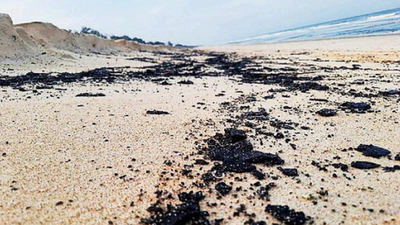- News
- City News
- mangaluru News
- Tar balls surface on Kodi Beach, can harm turtles
Trending Topics
Tar balls surface on Kodi Beach, can harm turtles

Tar balls at Kodi Beach in Kundapur
UDUPI: Conservationists, who are undertaking beach clean-up drives at the Kodi Beach in Kundapur, have noticed tar balls on the beach, before the onset of monsoon, for the fourth consecutive year. They believe that the presence of tar balls has increased this year.
Santhosh Kodi, mathematics teacher at Dr BR Ambedkar Residential School, Shankarnarayana, and a member of the Clean Kundapura project, who noticed tar balls at the beach on Tuesday morning, said, "Our major concern and fear is that the increasing tar ball presence pre-monsoon could harm the turtle nesting sites."
Kodi Beach is emerging as a hotspot for turtle conservation. It has seen more than 1,000 olive ridley hatchlings crawling into the sea from the 25 nesting sites around Kundapur. Of the total nesting sites, 23 were found on Kodi Beach, and one each at Trasi, about 10km north of Kodi, and Koderi, about 15km north of Kodi.
"Once the beach cleaning activity was undertaken, we started noticing the Olive Ridley turtle nesting sites. We suspect that there could be more nesting sites that may have gone unnoticed. Once monsoon sets in, the tar balls are covered with one layer of sand, which can pose a threat to the biodiversity. A week ago, we noticed that the water colour had turned black. This phenomenon is noticed across the coast, and it is important for scholars to conduct a study and understand the source of tar balls, to protect microorganisms in the area," Santhosh said.
It is suspected that accidental spillages during the transportation of crude oil, the release of ballast water from ships and operational discharge from offshore drilling, pipeline leakage and spills due to tanker accidents, are some of the major sources of oil for the formation of tar balls.
Menace increasing
Bharath Bangera of Clean Kundapura Project said that the presence of tar balls is only increasing over the years. Based on the colour and smell, a report by NITK on the samples tested a few years ago presumed that tar balls consist of petroleum hydrocarbons. Since it is attached to sand, it is not easily extractable for analysis.
"We have noticed that before the monsoon begins, the lighter components of oil parts float and come on the shore, and the heavier part settles down. The presence of tar balls is not restricted to Karnataka. It is found in Maharashtra and Goa. The matter has to be escalated to the ministry level, to find a solution. We have also drawn the attention of the PMO and the ministry of environment and forests. Anyone walking barefoot on the beach will understand the problem," he said.
Santhosh Kodi, mathematics teacher at Dr BR Ambedkar Residential School, Shankarnarayana, and a member of the Clean Kundapura project, who noticed tar balls at the beach on Tuesday morning, said, "Our major concern and fear is that the increasing tar ball presence pre-monsoon could harm the turtle nesting sites."
Kodi Beach is emerging as a hotspot for turtle conservation. It has seen more than 1,000 olive ridley hatchlings crawling into the sea from the 25 nesting sites around Kundapur. Of the total nesting sites, 23 were found on Kodi Beach, and one each at Trasi, about 10km north of Kodi, and Koderi, about 15km north of Kodi.
"Once the beach cleaning activity was undertaken, we started noticing the Olive Ridley turtle nesting sites. We suspect that there could be more nesting sites that may have gone unnoticed. Once monsoon sets in, the tar balls are covered with one layer of sand, which can pose a threat to the biodiversity. A week ago, we noticed that the water colour had turned black. This phenomenon is noticed across the coast, and it is important for scholars to conduct a study and understand the source of tar balls, to protect microorganisms in the area," Santhosh said.
It is suspected that accidental spillages during the transportation of crude oil, the release of ballast water from ships and operational discharge from offshore drilling, pipeline leakage and spills due to tanker accidents, are some of the major sources of oil for the formation of tar balls.
Menace increasing
Bharath Bangera of Clean Kundapura Project said that the presence of tar balls is only increasing over the years. Based on the colour and smell, a report by NITK on the samples tested a few years ago presumed that tar balls consist of petroleum hydrocarbons. Since it is attached to sand, it is not easily extractable for analysis.
"We have noticed that before the monsoon begins, the lighter components of oil parts float and come on the shore, and the heavier part settles down. The presence of tar balls is not restricted to Karnataka. It is found in Maharashtra and Goa. The matter has to be escalated to the ministry level, to find a solution. We have also drawn the attention of the PMO and the ministry of environment and forests. Anyone walking barefoot on the beach will understand the problem," he said.

About the Author
Deepthi SanjivDeputy Chief of Bureau at TOI, Mangaluru. Writes on crime, environment, health, politics, education, civic issues, art & culture and human interest stories.
Start a Conversation
FOLLOW US ON SOCIAL MEDIA
FacebookTwitterInstagramKOO APPYOUTUBE










